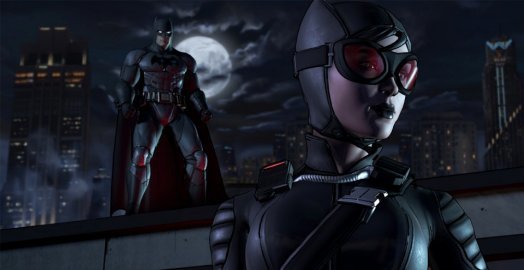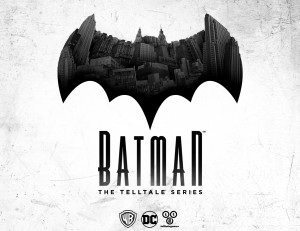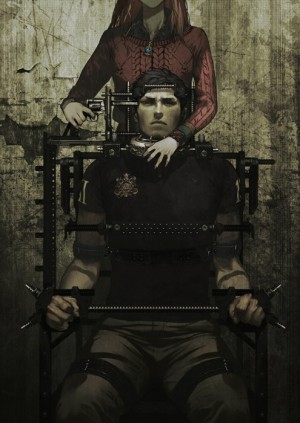Review for Batman: The Telltale Series

Batman is perhaps the biggest franchise that Telltale has tackled yet – or at least the most enduring. The caped crusader spans generations and has appeared in every medium imaginable, undergoing multiple iterations over the years while retaining the same core characteristics. The developer, meanwhile, has become synonymous with a particular type of episodic interactive storytelling that is heavy on conversation, player choice, and simplified action-based gameplay. A few new mechanics are introduced here, but Telltale’s Batman doesn’t stray far from the tried and tested formula. For the source material, though, it works quite well, allowing us to explore both Bruce Wayne and Batman while making use of different techniques.
Early in the five-part series, the focus is more on Bruce, the millionaire man behind the mask, though the balance levels out as the story progresses. You occasionally even get to choose which persona you wish to adopt to approach a situation, which is a welcome touch. It’s as Bruce that you get to converse with people the most, mingling with the rich, the mob and the press in your high-profile role as supporter and financial backer of mayoral candidate Harvey Dent. Anyone familiar with Batman stories will know the traditional future for Harvey, which ruins any semblance of surprise when the inevitable happens. While he’s an imposing presence, towering over Bruce, at first he’s a man who genuinely seems to want to do better for the city of Gotham.
Our first interactions with Bruce take place at Wayne Manor, hosting an event for Harvey and hobnobbing with the affluent folks in attendance. One of Harvey’s main platforms is that he’ll be replacing Arkham Asylum, home to the mentally unstable, with a brand new psychiatric health facility. Bruce is clearly a trusted figure and politically influential, though public perception towards his secret alter ego is mixed. Nevertheless, it’s here that you can begin shaping the character. During conversation you’ll get a choice of four dialogue options at particular points; whether you choose to be flirtatious, sarcastic or direct is up to you. Some of these choices are given more weight than others, but each will make you ponder and there’s a good number of them spread throughout the dialogue.
It isn’t long into the campaign party before Carmine Falcone and his cronies enter uninvited. A businessman with a suspect reputation, Falcone is old and short-tempered, eager to flex his figurative muscle and further exert his control. Whether you choose to shake his hand in front of your guests, for instance, is something that will have a ripple effect. A timer quickly runs down, forcing you to be snappy with your decision. There isn’t a "right" choice with such dilemmas, and you never really know what the repercussions are going to be. Though some might only alter the next line of dialogue rather than anything more meaningful, it’s always fun whenever you get to provide input.
There’s no messing around when it comes to introducing the typical cast of franchise characters, including Catwoman and James Gordon (still a Lieutenant here, not yet in his more familiar role as Commissioner). But that’s a good thing because it establishes them quickly, leaving them room to develop in later episodes. The opening instalment had me worried that the series was just going to endlessly tread ground already well covered elsewhere: we learn Bruce’s parents were killed when he was younger and that Gotham’s dirty streets are fuelled by government ties to crime, for example. But the series ends up doing a good job of shaking up the formula, though not always to great success.
For example, Oz Cobblepot (a.k.a The Penguin) is reimagined as Bruce’s childhood friend who returns to Gotham with a string of crimes under his belt, frustrated to see how the park his parents built has turned desolate while his old pal is living the high life. He’s a threatening and unpredictable presence, saying he plans to dismantle the hierarchy, though his dodgy and fake-sounding British accent is off-putting. It’s he who mostly takes prominence as a foe throughout the series, associating himself with a menacing group called the Children of Arkham, though the fact that this guy so quickly turns on Bruce is never made particularly believable.
There’s also the mystery of who the disguised figure leading the Children of Arkham actually is. The company is ominous, and their fights with Batman demonstrate the power they wield even against someone so well-trained and resourceful, but the eventual reveal of the person behind the mask is frankly stupid. It makes little sense given what we’ve been presented beforehand and seems to come out of nowhere for the sake of a twist. Further discoveries you make about this character’s backstory, while seemingly intended to build understanding of their motivations, are clichéd and tired. When the final battle rolled round I found myself disappointingly unengaged. Telltale can write better than this.
Life as Batman, costume and all, is focussed mainly around brawling and detective work. The former is where the action takes place, in a series of button prompts guiding you through every punch, kick and jump. The combat is extremely cinematic, making great use of a quick camera cuts, slow motion and brash sound effects. I really enjoyed watching these, especially because it never gets old having Batman creep up on his enemies and take them out in inventive ways with his gadgets. The moment we first catch sight of Batman, swinging across from another building and smashing through a window, is highly reminiscent of a scene in Christopher Nolan’s The Dark Knight film. The fight scenes are excellently choreographed throughout all five episodes and are a clear standout, especially a bar brawl that at first seems unfairly weighted to the enemy team.
It’s rare that you can actually fail during these action scenes, but there’s a reward for doing well. If you time your button responses properly, you’ll fill up a meter which allows you to deliver a powerful finishing move. Mess up badly and you might get a game-over screen, but you can instantly hop back in and won’t be penalised otherwise. It’s very forgiving, and perhaps too much so – on the one hand this maintains momentum no matter how you perform, but on the other it removes any real challenge and makes you question why you’re actually bothering to press anything in the first place.
You get choices to make as Batman too. The ones you make as Bruce will often affect people’s opinion of you; those you make as Batman will do the same, just with more violence involved. On multiple occasions, you can choose to show someone mercy or hand them over to the police. I chose to play as mercifully as possible, so I was frustrated when Alfred berated me for beating a man “half to death” when I purposely chose to do otherwise. I tried to maintain a pacifist approach (well, as much as is allowed!) throughout, though some conflict is inevitable.
The change in Bruce is what I found the most interesting narrative element. He discovers something about his family which shocks him and essentially makes him reassess everything he stands for and the people he loves. Public perception changes too, depending on your actions. For example, at a press conference you can choose to speak the words on the teleprompter and remain civil, or veer totally off-script and attempt to expose those you believe have done wrong. As usual for Telltale, consequences perhaps don’t always have the far-reaching impact they might, but it’s exciting to shape the situations as they play out.
Depending on how rigorously you follow a particular path, you can also explore Bruce’s tender side and pursue a relationship with Selina Kyle (Catwoman). Telltale’s Selina is very much her own woman, and Bruce is seduced by her brains, brawn and beauty. Yet while she has a fondness for Bruce, she’s also capable of giving him the cold shoulder. The ambivalence she feels about who she is and what she stands for is an intriguing one, and I wish it could have been developed a bit further. The relationship fizzles out by the fifth episode, with only a brief interaction between Bruce and Selina that lacks any spark, which is a shame.
The quieter side to Batman comes with investigation. In the first episode, after being tipped off to check out a warehouse by the docks, the sight that greets you inside is a gruesome one: dead bodies and entrails are littered around, with scorch marks from an explosion on the floor. As your detective work progresses throughout the season, you’ll be exposed to more violence, whether defending hostages from gunfire or stumbling across a suburban murder. There are a few instances where the game isn’t on rails, letting you walk around at your leisure, though these areas are always very self-contained with minimal hotspot interaction outside those that advance the story, which can be limiting. This is summed up pretty well in the park, where you can look at some boring graffiti on the wall, which Bruce doesn’t even bother commenting on.
Once you’ve checked out a crime scene, you can begin to sort through the evidence to work out what went down. What caused the explosion? Where did the bullets come from? The answers to such questions can be found by linking hotspots – clicking one and then another to establish a correlation. You’ll know by Batman’s response whether you got it right or not. When complete, the scene will be neatly re-enacted thanks to our lead’s advanced technology. The mechanic is simple, but offers a welcome change of pace and it’s good to see Telltale trying new things. Yet while this is used to great effect early on, it soon becomes an excuse for player interaction where there isn’t any needed, sometimes forcing you to link clues so obviously connected that you will likely have a grasp of exactly what happened before Batman pieces it together.
There’s an impressive cast of actors voicing the characters, many of which will be familiar if you’ve played any of Telltale’s recent games. For the most part they do well, like Laura Bailey bringing a sassy mystique to Catwoman and Travis Willingham a certain gravitas to Harvey Dent. Troy Baker does a top job in the dual lead role, giving Bruce the necessary suavity and Batman the aggression. His portrayal of Bruce is particularly noteworthy as the protagonist becomes more uncertain and conflicted in his emotions, lending credible vulnerability to a man who appears to have none on the surface. While the first episode suffers from occasional stiltedness in the line delivery, either from wrong intonation or lack of emotion, perhaps the actors just took a while to settle into their roles, as the remaining episodes don’t suffer from the same problem.
Telltale’s Batman has a semi-realistic appearance, with thick outlines and inky, comic book-style textures and exaggerated facial expressions. It looks its best during the night, and wisely the majority of scenes are set when the sun is down. The entire opening sequence is testament to this: Within the confines of the Mayor’s office, long shadows are cast and gunfire sparks up the room. Up on the rooftops, the glowing metropolis surrounds you in a sea of skyscrapers and smoke. When a news helicopter joins the fray, casting its bright spotlight on events, everything feels even more pronounced. When I think of Batman, this is the type of imagery that comes to mind and it’s realised nicely here: dark and industrial, exactly the sort of setting where it makes sense for a menacing man wearing a caped black costume to perform stealthy takedowns.
While the grittiness of Gotham is retained throughout the series, I found myself increasingly uninspired by the locales. You get to visit Arkham Asylum, Wayne Enterprises and other established locations, but there’s nothing particularly different or exciting about them. The former simply looks like a bog-standard prison; it would have been nice to see more visual flair in such an infamous setting. You also spend a lot of time either in areas that look very similar to one another, like alleyways and rooftops, or just places you’ve been to plenty of times already. The one environment I thought was most interesting was the house of someone you get close to, allowing you to peel back their façade and discover their real personality beneath.
Telltale’s regular composer Jared Emerson-Johnson never disappoints with his music and it’s no different here; the soundtrack throughout is excellent. There are the obvious upbeat tunes accompanying the action, with their rumbling drums and reverberations providing a heightened sense of pace and thrill, but the quieter tunes shouldn’t be discounted either. When Bruce is sitting across the table from someone, both parties more exposed than they would like, the slow piano background lends the scene a hint of melancholy and intrigue.
Disappointingly, technical issues interfered with my overall PC experience, despite my system more than meeting the requirements. There was an update released soon after launch, then another following episode four that supposedly resolved a lot of problems – better late than never, perhaps, but I found it had no impact anyway. I observed screen tearing and out-of-sync voices, but most frustrating was the slight pause every time there was a hard cut between scenes. This was especially unforgivable in the opening act, which switches periodically between Batman and Bruce in past and present, something that would have been very stylish had there not been such a clear lag each time it changed. Telltale has long suffered from poor optimization in their games and there’s really no excuse for it.
Each of the five episodes clocks in at about two hours maximum, some a good half-hour less, which feels like a satisfying length now that the season has come to a close. While some episodes advance the story better than others (episode four is a particular weak point), the balance between Bruce and Batman is always well distributed, emphasising the personal and political sides of the former and the punchy thrills and detective work of the latter. I had a decent time playing Batman, thanks mostly to its strong action scenes and cinematic presentation, but for an experience that relies so heavily on the story, it falls short a bit too often to overlook. While I don’t look for believability in the world of Batman (this is a man who fights crime in a costume, after all), I do expect it from character relationships and that kind of authenticity is not always felt here. Fans of the caped crusader or Telltale’s gameplay-lite form of interactive entertainment will likely find this an entertaining enough ride, but hopefully things can be stepped up a notch for the heavily-hinted sequel.

















![Event[0] - Game Review](https://cdn.nivoli.com/adventuregamers/images/screenshots/31241/image001__medium.jpg)














